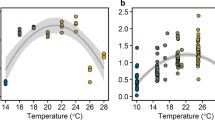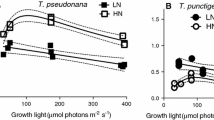Abstract
A change in the Si:N ratio of diatom cells during growth was examined for Chaetoceros socialis and Thalassiosira sp., with different initial silicate to nitrate (Si:N) ratios in the media. During exponential growth, C. socialis assimilated silicate and nitrate with a molar ratio of 0.5, independent of the ratio in the media, but after the depletion of nitrate, silicate continued to be taken up, and the Si:N ratio in the stationary phase increased to 2 as a function of the Si:N ratios in the media. In contrast, the ratio of silicate to nitrate taken up by Thalassiosira sp. increased with an increase in the Si:N ratio in the media. The Si:N ratio in the cells during the stationary phase increased in response to an increase in this ratio in the media. The Si:chl a ratio also increased with the increase in the initial Si:N ratio in the media, while the N:chl a ratio did not change to a great extent, indicating the changes in the cellular Si:N ratio was derived from changes in the Si content of the cells. These results indicated that the cellular Si:N ratio changed with the Si:N ratio in the medium, and the Si:N uptake ratio during the growth phase was different depending on diatom species. Thus, the dominance of different diatom species may affect nutrient composition and dynamics in the ocean.







Similar content being viewed by others
References
Broecker WS, Peng T-H (1982) Tracers in the sea. Columbia University, Palisades, N.Y.
Brzezinski MA (1985) The Si:C:N ratio of marine diatoms: interspecific variability and the effect of some environmental variables. J Phycol 21:347–357
Davis CO (1976) Continuous culture of marine diatoms under silicate limitation. II. Effect of light intensity on growth and nutrient uptake of Skeletonema costatum. J Phycol 12:291–300
Eppley RW, Strickland JDH (1968) Kinetics of marine phytoplankton growth. In: Droop MR, Wood EJF (eds) Advances in microbiology of the sea. Academic, London
Eppley RW, Holms RW, Paasche E (1967) Periodicity in cell division and physiological behavior of Ditylum brightwellii, a marine planktonic diatom, during growth in light–dark cycles. Arch Microbiol 56:305–323
Falkowski PG, Dubinsky Z, Wyman K (1985) Growth–irradiance relationships in phytoplankton. Limnol Oceanogr 30:311–321
Garrison DL (1981) Monterey Bay phytoplankton. II. Resting spore cycles in coastal diatom populations. J Plankton Res 3:137–156
Goldman JC (1979) Temperature effects on steady-state growth, phosphorus uptake and chemical composition of a marine phytoplankter. Microb Ecol 5:153–156
Hargraves PE, French FW (1980) Physiological characteristics of plankton diatom resting spores. Mar Biol Lett 1:185–195
Harrison PJ, Conway HL, Dugdale RC (1976) Marine diatoms grown in chemostats under silicate or ammonium limitation. I. Cellular chemical composition and steady state growth kinetics of Skeletonema costatum. Mar Biol 35:187–199
Harrison PJ, Conway HL, Holmes RW, Davis CO (1977) Marine diatoms grown in chemostats under silicate or ammonium limitation. III. Cellular chemical composition and morphology of Chaetoceros debilis, Skeletonema costatum, and Thalassiosira gravida. Mar Biol 43:19–31
Harrison PJ, Waters RE, Taylor FJR (1980) A broad spectrum artificial seawater medium for coastal and open ocean phytoplankton. J Phycol 16:28–35
Hollibaugh JT, Seibert DL, Thomas WH (1981) Observations on the survival and germination of resting spores of three Chaetoceros (Bacillariophyceae) species. J Phycol 17:1–9
Hutchins DA, Bruland KW (1998) Iron-limited diatom growth and Si:N uptake ratios in a coastal upwelling regime. Nature 393:561–564
Kamykowski D (1974) Physical and biological characteristics of an upwelling at a station off La Jolla, California. Estuar Coast Mar Sci 2:425–432
Kudo I, Matsunaga K (1999) Environmental factors affecting the occurrence and production of the spring phytoplankton bloom in Funka Bay, Japan. J Oceanogr 55:505–513
Kudo I, Yoshimura T, Yanada M, Matsunaga K (2000) Exhaustion of nitrate terminates a phytoplankton bloom in Funka Bay, Japan: change in SiO4:NO3 consumption rate during the bloom. Mar Ecol Prog Ser 193:45–51
Kuwata A, Hama T, Takahashi M (1993) Ecophysiological characterization of two life forms, resting spores and resting cells, of a marine planktonic diatom, Chaetoceros pseudocurvisetus, formed under nutrient depletion. Mar Ecol Prog Ser 102:245–255
Levasseur ME, Therriault J-C (1987) Phytoplankton biomass and nutrient dynamics in a tidally induced upwelling: the role of the NO3:SiO4 ratio. Mar Ecol Prog Ser 39:87–97
Martin-Jezequel V, Hildebrand M, Brzezinski MA (2000) Silicon metabolism in diatoms: implications for growth. J Phycol 36:821–840
McQuoid MR, Hobson LA (1996) Diatom resting stages. J Phycol 32:889–902
Nakata K (1982) Species composition of phytoplankton community of Funka Bay in the spring bloom, 1981. Bull Jpn Soc Fish Oceanogr 41:27–32
Odate T, Maita Y (1990) Seasonal distribution and vertical flux of resting spores of Chaetoceros (Bacillariophyceae) species in the neritic water of Funka Bay, Japan. Bull Fac Fish Hokkaido Univ 41:1–7
Oku O, Kamatani A (1995) Resting spore formation and phosphorus composition of the marine diatom Chaetoceros pserdocurvisetus under various nutrient conditions. Mar Biol 123:393–399
Oku O, Kamatani A (1997) Resting spore formation of the marine planktonic diatom Chaetoceros anastomosans induced by high salinity and nitrogen depletion. Mar Biol 127:515–520
Paasche E (1973) Silicon and the ecology of marine plankton diatoms. II. Silicate uptake kinetics in five diatom species. Mar Biol 19:262–269
Paasche E (1980) Silicon content of five marine plankton diatom species measured with a rapid filter method. Limnol Oceanogr 25:474–480
Parsons TR, Stephens K, Strickland JDH (1961) On the chemical composition of eleven species of marine phytoplankters. J Fish Res Board Can 18:1001–1016
Parsons TR, Maita Y, Lalli C (1984) A manual of chemical and biological methods for seawater analysis. Pergamon, New York
Rhee G-Y (1978) Effects of N:P atomic ratios and nitrate limitation on algal growth, cell composition, and nitrate uptake. Limnol Oceanogr 23:10–25
Sakshaug E, Andresen K, Kiefer DA (1989) A steady state description of growth and light absorption in the marine planktonic diatom Skeletonema costatum. Limnol Oceanogr 34:198–205
Suzuki R, Ishimaru T (1990) An improved method for the determination of phytoplankton chlorophyll using N, N-dimethylformamide. J Oceanogr Soc Jpn 46:190–194
Takeda S (1998) Influence of iron availability on nutrient consumption ratio of diatoms in oceanic waters. Nature 393:774–777
Tomas CR (1997) Identifying marine phytoplankton. Academic, San Diego
Yoder JA (1979) Effect of temperature on light-limited growth and chemical composition of Skeletonema costatum (Bacillariophyceae). J Phycol 15:362–370
Acknowledgements
The author expresses special thanks to Dr. P.J. Harrison for reading a draft of the manuscript and for helpful comments. This manuscript was greatly improved by the comments of anonymous reviewers.
Author information
Authors and Affiliations
Corresponding author
Additional information
Communicated by T. Ikeda, Hakodate
Rights and permissions
About this article
Cite this article
Kudo, I. Change in the uptake and cellular Si:N ratio in diatoms responding to the ambient Si:N ratio and growth phase. Marine Biology 143, 39–46 (2003). https://doi.org/10.1007/s00227-003-1063-2
Received:
Accepted:
Published:
Issue Date:
DOI: https://doi.org/10.1007/s00227-003-1063-2




